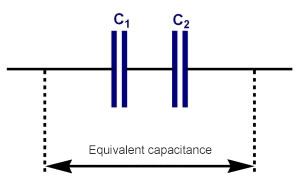Calculate the optional capacitor based on the required capacity
Calculate the total capacity according to each series capacity.
|
1. total electricity = power of series capacitor. QT=Q1=Q2=Q3....
2. the total voltage = the voltage of each series capacitor., E=V1+V2+V3....
3. reciprocal of total capacitance = reciprocal sum of series capacitance. 1 / CT = 1 / C1 +
1 / C2 +………
4. total energy = energy of each series capacitor.,
WT=W1+W2+W3....
Pressure calculation formula:
Total voltage:U
U1=C2*U/(C1+C2)
U2=C1*U/(C1+C2)
Example:C1 is 10UF C2 is 22UF
The upper formula shows that the voltage at both ends of C1 is 15.62V, and the voltage at both ends of C2 is 34.74V.When the capacitor is connected in series, the voltage and capacitance value are inversely proportional to each other.。
But when one capacitor breaks down due to various reasons, it is not very reliable to add the total voltage to the other capacitor. Therefore, the series of high-voltage capacitors should be treated with caution.
For high voltage circuits, capacitors in series will not be ideal for "automatic" distribution withstand voltage, and must be separately and on hundreds of K_or M_above the voltage divider resistance.
|
|

